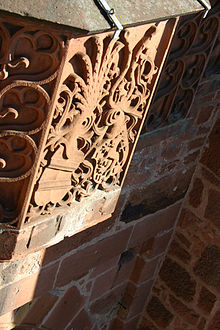Untertor (Büdingen)
The Untertor (also popularly known as the Jerusalem Gate or Kreuztor ) is a medieval double tower complex with a city gate that forms the western entrance to the historic old town of Büdingen in Hesse in Germany . As the most striking building, it is the symbol of the city. The entire complex of Büdingen's old town is considered a protected cultural asset according to the Hague Convention for the Protection of Cultural Property in the Event of Armed Conflict .
The fish-bubble tracery on the parapet and the lion-shaped gargoyle are noteworthy. An alliance coat of arms of Ludwig II of Ysenburg and his wife Maria von Nassau adorns the sinkhole bay . The four stone domes that cover the tower and staircase are unique.
The construction
The outer diameter of a tower is 3.90 meters in the middle floor, the wall thickness varies between 1.60 meters in the lower floor and 1.20 meters in the upper of the three fighting stalls. There are three rifle stations on each floor, so there are 18 loopholes for both towers. In addition, the battlements and the pitch bay above the gate could be manned with shooters. The loopholes are only about one meter above the respective floor, it is therefore assumed that the shooters shot while sitting on a chair or stool. Although each notch is only about 20 cm high and 35 cm wide, the horizontal shooting angle was almost 90 degrees due to the large aperture.
history
As early as 1353, Büdingen had a city wall with several defense towers and two city gates. However, since the population increased and the walls were no longer able to withstand the artillery weapons of later years, Count Ludwig II of Ysenburg decided in 1476 to build another, stronger ring of fortifications with double walls, mighty ramparts and a moat.
The building was completed in 1503 with the new city gate, the lower gate. Originally there was a drawbridge in front of the gate, which spanned a moat. The bridge has been exposed again since the renovation in 2003.
Naming
According to tradition, a son of the count brought the design of the gate with him from a pilgrimage from Jerusalem , hence the nickname Jerusalem Gate . It is said to be a copy of the sheep gate in Jerusalem. A direct comparison of images refutes this thesis, although the pilgrimage itself is documented.
Another theory is considered more likely: Since Büdingen became Protestant very early in 1521 , many religious refugees such as Huguenots and Waldensians came to the city. When they arrived at the city gate, they knelt and prayed. Here they are also said to have said "... this is our Jerusalem ...".
The nickname Jerusalem Gate has only been used since the middle of the 19th century .
use
Like the other fortifications, the gate was built from red sandstone extracted from the Büdingen quarries. Today the two towers are home to the small sand rose museum.
The gate was restored several times, most recently in the years 2003 / 2006 .
Detail: gargoyles in winter
Literature / sources
- In defense of Büdingen during the Renaissance II period by Dr. Walter Niess
- Hans-Velten Heuson: Büdingen - Yesterday and Today: Works on the history of the city and its surroundings (1300–1945) . Collection of articles by Hans-Velten Heuson. Edited by Volkmar Stein, Büdingen 2004, 293 pages, A4.
Web links
- Rifle Society from 1353 with stories and transcripts of documents about the fortifications.
Coordinates: 50 ° 17 ′ 33 " N , 9 ° 6 ′ 53" E







